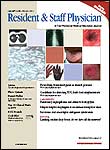Publication
Article
Resident & Staff Physician®
Pediatric Medicine
Prepared by Suraj S. Venna, MD, Clinical Assistant Professor, Department of Dermatology, University of California at San Francisco, and Daniel S. Loo, MD, Associate Professor,Department of Dermatology, Tufts University, Boston, Mass
A 6-month-old male infant presented to the emergency department with a 1-month history of a nonhealing ulcer on the right buttock (Figure). The red, raised lesion was evident soon after birth. The baby?s mother had noted that he was increasingly irritable and uncomfortable; the infant was otherwise well and had no fever or signs of skin infection. He was born full-term, without any complications.
Figure
What's Your Diagnosis?
- Subcutaneous fat necrosis
- Invasive fungal dermatitis
- Ulcerated hemangioma
- Pyoderma gangrenosum
Quiz Answer
Ulcerated hemangioma—In this case and in general, the diagnosis is made clinically from the history, morphology, and location of the lesion. Hemangiomas are benign vascular tumors characterized by a natural history of growth and regression. The most common type of hemangioma is the strawberry hemangioma, present in 2.6% of newborns and in 8% to 12% of white infants by age 1 year.1 Cavernous hemangiomas are deeper seated and are seen in 1% to 2% of healthy newborns.1 The majority of hemangiomas presentwithin the first few months of life, with the majority occurring by the end of the first postnatal month. Approximately half of patients have complete involution by age 5 years. Asthe hemangioma flattens, the color evolves from bright red to dull red; a gray-blue hue is often seen at the time of near-complete involution. Involution is not synonymous with resolution of the lesion. Mild residual changes, including telangiectasias, atrophic wrinkling, or yellowish discoloration, may result. It is very important to reassure parents about the benign nature of the growth.
Complications of involuting hemangiomas are rare; however, ulceration, bleeding, scarring, or infection can occur. Ulceration is the most common complication and may be related to the recurrent maceration and friction at a particular site, such as the perineum. Careful wound care is essential to prevent bacterial superinfection and to provide pain relief. The ulcerated area should be gently cleansed with antibacterial soap. Medical treatments include antibiotics (topical or oral), such as topical metronidazole gel (Flagyl, MetroGel);barrier creams, such as zinc oxide; bioocclusive dressings to be applied directly to the wound, such as hydrocolloids (eg, DuoDerm Extra Thin, Tegasorb); and corticosteroids (oral or intralesional) to promote complete involution.1,2 Laser treatment has been reported to promote reepithelialization of these ulcers and to relieve pain.2,3
A case of an ulcerated hemangioma responding to becaplermin gel (Regranex Gel) was reported in 2002, and a recent article reported a case series of 8 infants with large perinealulcerated hemangiomas treated with daily applications of becaplermin gel, all healing within 3 to 21 days.4,5
Pain control for infants can be managed with oral acetaminophen or a topical anesthetic, such as lidocaine. Parents should be counseled on the potential toxic effects of lidocaine and advised to apply a thin film no more than 3 times daily. The other lidocaine-containing topical anesthetic, lidocaine-prilocaine cream (EMLA Cream; lidocaine 2.5% and prilocaine 2.5% in an emulsion base), has been associated with infantile methemoglobinemia and generally should be avoided, although recent studies have shown that single doses of lidocaine-prilocaine cream do not cause significant methemoglobinemia.6,7
Our patient was treated with a hydrocolloid dressing and the ulcerated area healed completely within 4 weeks. The advantages of this dressing are: it can be cut to fit; it can be changed once every 3 to 5 days; it has a cooling and soothing effect; and it forms a physical barrier from further trauma or potential contamination from feces and urine.
Subcutaneous fat necrosis of the newborn is a self-limited panniculitis, presenting within the first few weeks of life as indurated, erythematous nodules and plaques involving thetrunk, buttocks, arms, and cheeks. On rare occasions, it is associated with hypercalcemia.
Candida albicans
Candida
Invasive fungal dermatitis is most often associated with neonatal candidiasis, occurring in premature infants weighing less than 1000 g. is the most common pathogen, but other species can cause this condition. Clinically, multiple erosive and ulcerative lesions occur and can mimic diaper dermatitis.
Pyoderma gangrenosum is rare in neonates and children, although it has been reported in a neonate as young as 3 weeks.8 A review of 46 childhood cases of pyoderma gangrenosum found that the lesions have the typical appearance of an ulcer, with an undermined, violaceous border. Infants were more likely than older children to have involvement ofthe perineal and genital area.
References
- Paller AS, Mancini AJ. Vascular disorders of infancy and childhood. In: Hurwitz Clinical Pediatric Dermatology: A Textbook of Skin Disorders in Childhood and Adolescence. 3rd ed. Philadelphia, Pa: Saunders; 2005:308-318.
- Kim HJ, Colombo M, Frieden IJ. Ulcerated hemangiomas: clinical characteristics and response to therapy. J Am Acad Dermatol. 2001; 44:962-972.
- David LR, Malek MM, Argenta LC. Efficacy of pulse dye laser therapy for the treatment of ulcerated haemangiomas: a review of 78 patients. Br J Plast Surg. 2003;56:317-327.
- Sugarman JL, Mauro TM, Frieden IJ. Treatment of an ulcerated hemangioma with recombinant platelet-derived growth factor. Arch Dermatol. 2002;138:314-316.
- Metz BJ, Rubenstein MC, Levy ML, et al. Response of ulcerated perineal hemangiomas of infancy to becaplermin gel, a recombinant human platelet-derived growth factor. Arch Dermatol. 2004;140:867-870.
- Taddio A, Ohlsson A, Einarson TR, et al. A systematic review of lidocaine-prilocaine cream (EMLA) in the treatment of acute pain in neonates. Pediatrics. 1998;101:E1.
- Taddio A, Stevens B, Craig K, et al. Efficacy and safety of lidocaineprilocaine cream for pain during circumcision. N Engl J Med. 1997; 336:1197-1201.
- Graham JA, Hansen KK, Rabinowitz LG, et al. Pyoderma gangrenosum in infants and children. Pediatr Dermatol. 1994;11:10-17.
